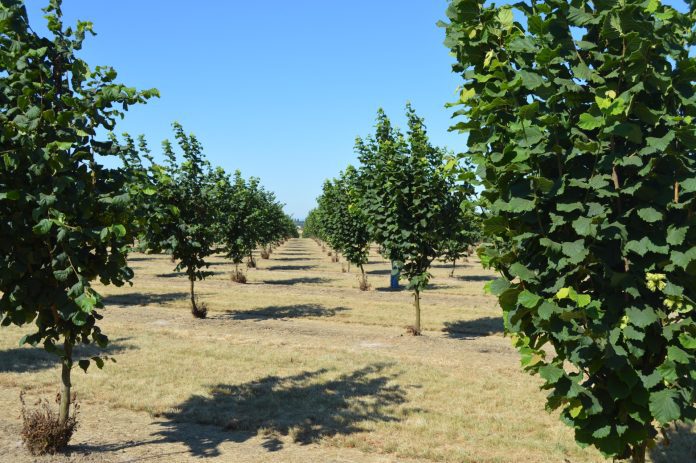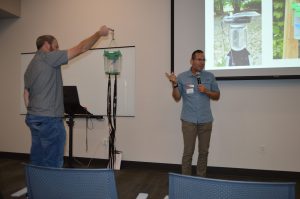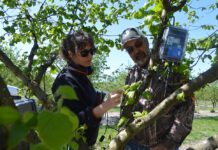
As recently as 10 years ago, despite dire warnings from East Coast researchers, Oregon State University Extension Entomologist Vaughn Walton did not think brown marmorated stink bug (BMSB) would be a big issue in hazelnuts.
He has since changed his tune.
“We’ve been in several orchards in the last few years where I’m seeing it is here, and it is causing an issue,” Walton said in a presentation at the Nut Growers Society’s Summer Tour on August 2 in Albany, Ore.
“The scientists on the East Coast would tell us, ‘This is going to be the worst problem that you’ve ever had,’” Walston added. “I did not believe that. I did not believe it would cause an economic issue. But now I’m a believer.”
Stink bugs first emerged as a pest of concern in agriculture in the Eastern U.S. in the 2000s. By 2010, it was causing significant crop loss in orchards back East. In Oregon, the pest was first found in the Portland area in 2004. Walton started monitoring for the pest after seeing it in orchards for the first time nine years ago in the Beaverton, Ore., area.
The pest damages hazelnuts by penetrating shells with mouth parts and injecting enzymes into nuts, which can lead to corky tissue, blanks and shriveled nuts. Often, Walton said, a grower won’t know there is a problem until after harvest.
“You will only see this after you crack those nuts open,” he said. “You’ll harvest them. You’ll put all that seasonal energy and money to keep those nuts clean. And this will be the product you will only see after the nuts are cut open.”
Walton said he has found between 16% and 18% of crop loss to the pest in some orchards. Also, according to OSU Extension Orchard Specialist Nik Wiman, packers are now checking for stink bugs as part of their insect damage sampling protocol.
The pest can inflict damage throughout a season, Walton said, but is most damaging in late season. In one test conducted in 2022, researchers measured the percent corky tissue damage in one hazelnut orchard increased 6% between September 13 and October 11.
“If you are letting those nuts hang there and you are not protecting them, you’re going to be getting at least 5% or 6% extra damage in a bad scenario,” Walton said. “Late season is when we really do need to protect the nuts from stink bug.”
Early season infestations of stink bugs also should be avoided if possible, Walton said. “If you have early stink bug pressure in your orchard, you’re not only getting corky tissue, you’re also getting blanks and you’re also getting shriveled nuts,” he said.
Traps should be placed in the upper canopy of trees early in the season to get accurate counts. “The stink bugs will be in that upper portion of the canopy,” Walton said.

Pest Complexities
Stink bugs are adding to an already diverse pest complex in hazelnuts that is getting increasingly difficult to manage, Walton said. “We used to only worry about filbert worm. The only thing we needed to worry about was to put out a spray on the Fourth of July. In the new world, with this bug, we are going to have to be aware throughout the season,” he said.
“And the filbert worm seems to be becoming an increasingly difficult problem to deal with as well,” Walton said. “We are not seeing that extreme peak on the Fourth of July anymore. Now we’ve got this filbert worm emerging in May, and they’re just hanging in there, and people are finding their peak numbers in late July, early August.”
Efforts to control the BMSB have also exacerbated issues with aphids, according to Wiman, particularly because the only materials that control both stink bug and filbert worms are nonselective materials that are affecting populations of the parasitoid wasp Trioxys pallidus, which, until recently, has been effective at keeping down aphid populations.
Wiman said he is seeing more aphid pressure in recent years because of this.

Shell Thickness
At one point, researchers had hoped that thicker-shelled hazelnut varieties would lend some resistance to stink bugs. But, Walton said, that has not been proven to be the case.
“Irrespective of shell thickness, these bugs can still cause damage,” he said. “That shell can be the thickest shell you can find, and the stink bug will stick its mouthparts in there, it will inject enzymes into it, and it will move its tongue around.”
Researchers also had hoped to have determined an action threshold for stink bug by now, but to date, their research has failed to show a clear relationship between trap counts and crop damage in hazelnuts, Wiman said.
“So, we are just using the traps as an indicator of presence,” Wiman said. “We need to get better IPM tactics for the stink bug so that we can use sprays against stink bug more judiciously.”
Multiple Hosts
Stink bugs enter orchards from a variety of sites including outbuildings and alternative host plants that are present near an orchard. In its nymphal stages, the bug lodges itself between the husk and nut in a hazelnut tree and is very difficult to see, Walton said.
“The majority of orchards that are mature can be up to 20 feet high and the nuts are in that upper portion of the canopy, so you’re not going to be seeing brown marmorated stink bug in that orchard until it’s too late, until you are hearing from your packer or your dryer,” he said.
“Late in the season, when you start getting numbers like 70 bugs per trap, the damage has already been done,” Walton said. “It’s too late at that stage, so we need to try and catch this a little bit earlier.”
As for the future, Walton said researchers are hoping to develop non-toxic products that will control stink bugs. Work to date indicates they may have tools utilizing fatty acid compounds to help control stink bugs within the next five years.
“There is light at the end of the tunnel,” he said. “I think we just need to keep at it.”











